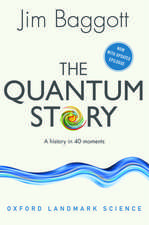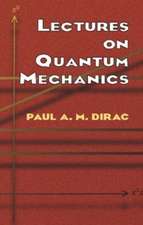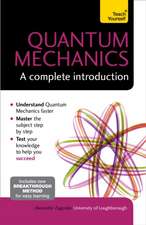Notes on Quantum Mechanics
Autor Enrico Fermien Limba Engleză Paperback – iul 1995
The lecture notes presented here in facsimile were prepared by Enrico Fermi for students taking his course at the University of Chicago in 1954. They are vivid examples of his unique ability to lecture simply and clearly on the most essential aspects of quantum mechanics.
At the close of each lecture, Fermi created a single problem for his students. These challenging exercises were not included in Fermi's notes but were preserved in the notes of his students. This second edition includes a set of these assigned problems as compiled by one of his former students, Robert A. Schluter.
Enrico Fermi was awarded the Nobel Prize for Physics in 1938.
At the close of each lecture, Fermi created a single problem for his students. These challenging exercises were not included in Fermi's notes but were preserved in the notes of his students. This second edition includes a set of these assigned problems as compiled by one of his former students, Robert A. Schluter.
Enrico Fermi was awarded the Nobel Prize for Physics in 1938.
Preț: 255.63 lei
Nou
Puncte Express: 383
Preț estimativ în valută:
48.92€ • 53.35$ • 41.25£
48.92€ • 53.35$ • 41.25£
Carte tipărită la comandă
Livrare economică 24 aprilie-08 mai
Preluare comenzi: 021 569.72.76
Specificații
ISBN-13: 9780226243818
ISBN-10: 0226243818
Pagini: 191
Ilustrații: 5 line drawings
Dimensiuni: 152 x 229 x 13 mm
Greutate: 0.29 kg
Ediția:Second Edition
Editura: University of Chicago Press
Colecția University of Chicago Press
ISBN-10: 0226243818
Pagini: 191
Ilustrații: 5 line drawings
Dimensiuni: 152 x 229 x 13 mm
Greutate: 0.29 kg
Ediția:Second Edition
Editura: University of Chicago Press
Colecția University of Chicago Press
Cuprins
Preface to the First Edition
1: Optics - Mechanics Analogy
2: Schrodinger Equation
3: Simple One-Dimensional Problems
4: Linear Oscillator
5: W. K. B. Method
6: Spherical Harmonics
7: Central Forces
8: Hydrogen Atom
9: Orthogonality of Wave Functions
10: Linear Operators
11: Eigenvalues and Eigenfunction
12: Operators for Mass Point
13: Uncertainty Principle
14: Matrices
15: Hermitian Matrices - Eigenvalue Problems
16: Unitary Matrices - Transformations
17: Observables
18: The Angular Momentum
19: Time Dependence of Observables - Heisenberg Representation
20: Conservation Theorems
21: Time-Independent Perturbation Theory - Ritz Method
22: Case of Degeneracy or Quasi Degeneracy - Hydrogen Stark Effect
23: Time-Dependent Perturbation Theory - Born Approximation
24: Emission and Absorption of Radiation
25: Pauli Theory of Spin
26: Electron in Central Field
27: Anomalous Zeeman Effect
28: Addition of Angular Momentum Vectors
29: Atomic Multiplets
30: Systems with Identical Particles
31: Two-Electron System
32: Hydrogen Molecule
33: Collision Theory
34: Dirac's Theory of the Free Electron
35: Dirac Electron in Electromagnetic Field
36: Dirac Electron in Central Field - Hydrogen Atom
37: Transformations of Dirac Spinors
Introduction to Problems for Notes on Quantum Mechanics
Problems
1: Optics - Mechanics Analogy
2: Schrodinger Equation
3: Simple One-Dimensional Problems
4: Linear Oscillator
5: W. K. B. Method
6: Spherical Harmonics
7: Central Forces
8: Hydrogen Atom
9: Orthogonality of Wave Functions
10: Linear Operators
11: Eigenvalues and Eigenfunction
12: Operators for Mass Point
13: Uncertainty Principle
14: Matrices
15: Hermitian Matrices - Eigenvalue Problems
16: Unitary Matrices - Transformations
17: Observables
18: The Angular Momentum
19: Time Dependence of Observables - Heisenberg Representation
20: Conservation Theorems
21: Time-Independent Perturbation Theory - Ritz Method
22: Case of Degeneracy or Quasi Degeneracy - Hydrogen Stark Effect
23: Time-Dependent Perturbation Theory - Born Approximation
24: Emission and Absorption of Radiation
25: Pauli Theory of Spin
26: Electron in Central Field
27: Anomalous Zeeman Effect
28: Addition of Angular Momentum Vectors
29: Atomic Multiplets
30: Systems with Identical Particles
31: Two-Electron System
32: Hydrogen Molecule
33: Collision Theory
34: Dirac's Theory of the Free Electron
35: Dirac Electron in Electromagnetic Field
36: Dirac Electron in Central Field - Hydrogen Atom
37: Transformations of Dirac Spinors
Introduction to Problems for Notes on Quantum Mechanics
Problems















